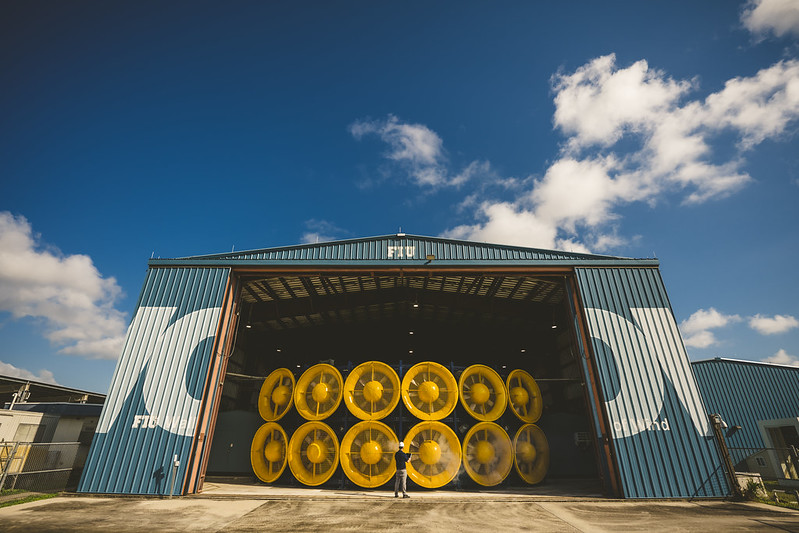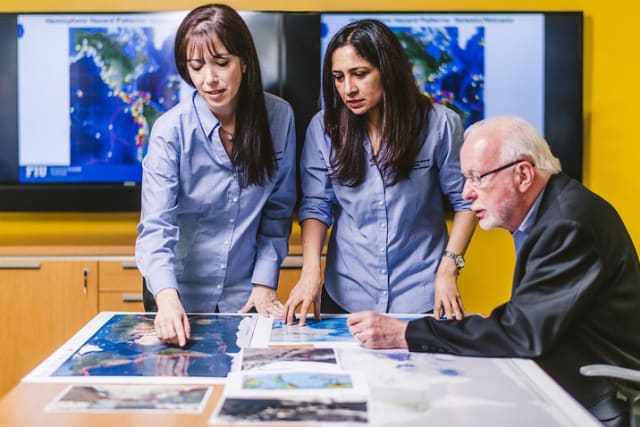Target 11.5 Reduce risks of natural disasters
By 2030, significantly reduce the number of deaths and the number of people affected and substantially decrease the direct economic losses relative to global gross domestic product caused by disasters, including water-related disasters, with a focus on protecting the poor and people in vulnerable situations

Extreme Events Institute
FIU's Extreme Events Institute is at the forefront of solutions-centered research and engagement for hurricanes and other extreme events. Comprising the International Hurricane Research Center and the Disaster Resilience and Climate in the Americas program, the institute is a globally involved center for research, education, and training in natural hazards and disaster-risk management. The Institute includes faculty and researchers from the social and behavioral sciences, engineering, computer science, earth and atmospheric sciences, public health, public administration, business, and architecture. The Extreme Events Institute manages the Wall of Wind Laboratory, which was established through a State of Florida Center of Excellence, and is funded through the NSF Natural Hazards Engineering Research Infrastructure program. The EEI also developed and manages the Florida Public Hurricane Loss Model.

Wall of Wind
The International Hurricane Research Center and FIU's College of Engineering and Computing built the full-scale Wall of Wind to test entire structures at full-scale, leading to performance-based design for hurricanes through direct correlation of wind speed with performance and damage levels. Similar to crash testing for vehicles, the Wall of Wind can test to failure full-sized structures such as manufactured housing and small commercial structures. Current WoW projects, funded by federal and state agencies and by private industry, are offering focus and leadership in the urgently needed hurricane engineering research and education from an integrative perspective to quantify and communicate hurricane risks and losses, mitigate hurricane impacts on the built environment, and enhance sustainability of infrastructure and business enterprise, including residential buildings, low-rise commercial buildings, power lines, traffic signals and more. The Wall of Wind is helping to build sound scientific basis for developing risk-based and performance-based design criteria, and contributing to the attainment of an international objective — achieving more sustainable coastal communities.

Institute for Resilient and Sustainable Coastal Infrastructure
FIU's Institute for Resilient and Sustainable Coastal Infrastructure identifies engineering solutions for challenges faced by aging infrastructure and develops innovative and economical technologies for the creation of resilient and sustainable communities. The economic prosperity of the United States is closely related to the health of the nation’s infrastructure, which includes aviation, bridges, dams, waterways, ports, rail, transportation and roadways. The institute is an umbrella organization that incorporates bridge engineering, the U.S. Department of Transportation-funded University Transportation Center, and the Lehman Center for Transportation Research.

Hurricane and Tropical Cyclone Forecasting
FIU's hurricane-focused research advances the science behind storms and suggests pragmatic strategies to protect human life. Their work is informing efforts at the National Hurricane Center and the U.S. Navy's Joint Typhoon Warning Center. FIU meteorologists are investigating hurricane intensity, intensity change and structures of inner-core convection and precipitation. They are engaging satellite remote sensing techniques to study hurricane rainfall, convection, winds, and warm-core structures. As part of their work, they have developed long-term satellite-based tropical cyclone databases and used these tools to study the climatology of hurricanes and to develop algorithms for estimating current intensity and predicting rapid intensification of tropical cyclones. FIU scientists are also working to improve existing forecast and modeling tools like the Hurricane Analysis and Forecast System. This new multi-scale operational model for tropical cyclone prediction fails to capture the intense turbulent mixing in eyewall and rainband clouds due to a poor estimation of static stability in clouds. Recent FIU research proposes a solution to this issue which could improve overall storm track and intensity predictions. Our scientists are also tackling storm surge from these intense storms, developing a reliable model for predicting surge to assist communities in evacuation-decision strategies.

Improving Resilience for Underserved and Neglected Populations
For decades, FIU researchers have worked to enhance the hurricane resilience of underserved and neglected populations. Recently, the United States Agency for International Development (USAID) has awarded the university nearly $8 million to address hurricane risks and develop resilience strategies in Latin America and the Caribbean — focusing on land-use management, building codes and preparedness. For Haiti and the Dominican Republic, FIU scientists have helped develop a storm surge database that is guiding decision-making of local officials for evacuations in storm events. And the National Oceanic and Atmospheric Administration (NOAA) has funded efforts to map and forecast flooding throughout the Caribbean to improve storm surge monitoring and warning for island nations and Central American coastal areas. Closer to home, the Andrew Mellon Foundation has supported FIU efforts to address the disproportionate impacts of hurricanes on low-income communities in South Florida. With 45 percent of the U.S. population living in hurricane-threatened states, the work being done in South Florida serves as a model for strategies all across the country.

Disaster Preparedness
FIU research is focused on building more resilient and sustainable communities through building adaptation, expanded use of technology and improved disaster planning. Our Sea Level Solutions Center is informing local governments and developers about the effectiveness of building-level adaptation strategies including cost-benefit analysis and sea level rise predictions. Damages to infrastructure as well culturally significant historic structures pose unique challenges for communities dealing with the aftermath of a natural disaster. FIU researchers have developed a new assessment model that could improve timeliness of damage assessments and more efficiently help local officials prioritize repair efforts. While most natural disaster are unpredictable, some, including hurricanes, offer some predictability. FIU researchers are studying storm preparation strategies including the positioning of post-storm supplies in advance of a hurricane making landfall. Their research is helping to inform local planning strategies to maximize resources and effectively serve people in affected communities after the storm.

Florida Public Hurricane Loss Model
The Florida Public Hurricane Loss Model was developed by FIU experts in meteorology, wind and structural engineering, computer science, GIS, statistics, finance and actuarial science. It is used to assess the state’s hurricane risk to regulate windstorm insurance rates and determine fair pricing in a state that saw insurers fail after 1992’s catastrophic Hurricane Andrew. Operated by FIU and funded by the FLorida Legislature, the model also evaluates the solubility of individual insurance companies and quantifies the economic benefits of mitigation efforts.

Category 6 Project
Though the Saffir-Simpson Hurricane Wind Scale only goes to Category 5, FIU researchers know increasingly stronger hurricanes are impacting coastal communities. With the support of the National Science Foundation, FIU is designing the most powerful wind-water-wave testing facility in the world, capable of generating wind speeds up to 200 miles-per-hour combined with a water basin to simulate storm surge and wave action. The FIU-led project is being developed in partnership with eight other universities from across the United States.

The WISE Research Group
The Water Resources Integrated Modeling and Smart Control of Extreme Weather Impacts (WISE) research group is working to support sustainable cities and communities through research in the areas of smart and resilient flood control, mitigation of violent geysers (air-water flows), optimal reservoir operation under uncertainty, sustainable stormwater management, computational hydraulics, and physical modeling of hydraulic structures.